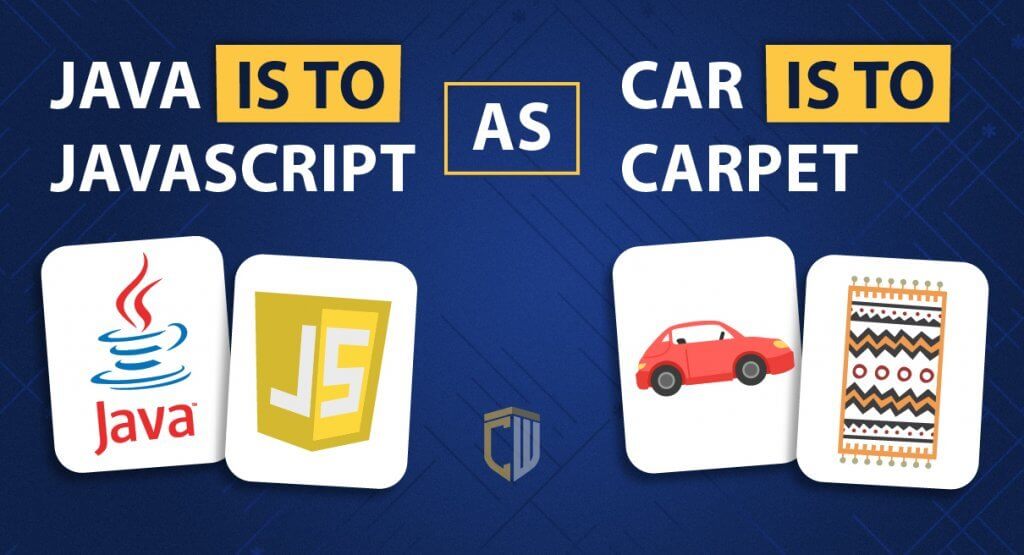Java and JavaScript have similar names, so they must be similar programming languages, right? While they both have “java” in them, they are actually two very different programming languages.
In fact, if you Google “java vs. javascript,” you’ll see many people have the same question. Both coding languages have been around a long time. But they are quite different, as you’re about to learn. One is a dominant tool in the world of enterprise software with a huge base of developers. The other is part of the three fundamental components of the world wide web. So, what’s the difference between Java and JavaScript?
What is Java?
Java is what’s known as a high-level programming language, which means that it’s much easier for humans to read than the complex (low-level) code computers understand. In this way, it’s similar to popular languages like Python and C#. Sun Microsystems released Java back in 1995. Nearly 30 years later, it’s in use by almost 9 million software developers.
There are several ideas behind Java as a coding language:
- Java uses a programming paradigm called object oriented programming. You’ll learn more about that in a moment.
- Java programs should be secure.
- Java is that programs built with it should run on any platform. That includes Windows, Mac, and Linux.
Software made with Java is also supposed to require very little support from what are called dependencies. A lot of programs rely on large collections of code written by others to function. These are dependencies.
Finally, Java is a compiled language. Put simply, a compiled language is one that goes through a process that translates it from human-readable format to something computers can read. This translation makes programs faster than those written in interpreted languages, like Python, which essentially translate as the code runs.
Java Features
Java is an object-oriented programming language. It uses classes, objects, and other related concepts. Classes are prototypes that define the characteristics of the objects that belong to them. Software engineers build programs by creating classes and defining all the things the objects that belong to those classes can do. Then they add objects to their software that do the actual work. A real-world analogy might be helpful: Imagine that “car” is a class. A car can move forward, backward, it can turn left and right, and come to an abrupt stop. The vehicle in your driveway can do all these things because it’s an object that belongs to the “car” class. Programmers would call every individual car an “instance” of the car object.
Java Applications
Java is responsible for some of the most powerful and popular pieces of software in the world. Minecraft, the biggest video game on the internet, was built with Java. More than 140 million players around the globe explore and build virtual creations in Minecraft’s 3D worlds. Zillow, the real estate website used by millions of people to search for houses, condos, and apartments, is a Java application. Acrobat Reader is a Java app that lets people open, review, and sign PDF documents. Amazon uses Java, and so do Netflix, Tinder, Google Earth, and Uber.
Recommended: Summer Minecraft Camp for Kids
Java Resources
Several resources can tell you more about Java, how it works, and how to use it. The best one to start with is probably the Java website from Oracle. You can download everything needed to write Java software and access tutorials here. There, you’ll also find Java Magazine, a helpful blog for those who want to go in-depth on Java technology.
If you’d like to get your student started with Java classes, online coding classes for kids are an excellent option:
- Java I Intro to Java: Kids learn what Java is and why it’s useful. They also learn the basic building blocks of the language, including its methods, decision-making statements, and data types.
- Java II Intermediate: This class builds on the information in the previous one and presents the concept of object-oriented programming. Students finish the class by building a project.
What is JavaScript?
JavaScript is what’s known as a scripting language. Its code doesn’t get compiled or translated before the computer runs it. JavaScript is a super popular language for web development and appears in countless websites. In fact, it’s in more than 95% of sites on the web. Front-end developers use it to control elements of a website’s user interface, also called a UI. They employ JavaScript to make objects on the screen respond to user input like mouse clicks and button presses. But this language isn’t limited to simple behaviors such as these. JavaScript’s numerous frameworks make it useful for building powerful web apps. These frameworks include Angular, maintained by Google and used in apps such as Gmail, PayPal, and Netflix. React, a framework created and used by Facebook, also powers parts of Instagram, WhatsApp, and Dropbox. There’s also Vue.js, Ember.js, and others.
JavaScript Features
Some of JavaScript’s most notable features include its ability to work with HTML forms. If a user forgets or fails to fill out a field, JavaScript can find out before submitting the form and instruct the person to enter the required information. Because JavaScript runs in the browser, it can do quick math without having to contact a server. Browsers of all kinds and on all platforms can run JavaScript code. Another great feature of JavaScript is that programmers can insert short bits of it directly into HTML files. They simply put their code between <script></script> tags.
JavaScript Applications
So many websites and web apps use JavaScript that it would be impossible to list even a fraction of them. PayPal, LinkedIn, Yahoo!, Mozilla, Uber, and nearly all the other big apps people use on the web rely on JavaScript for part of their functionality. Often, JavaScript handles front-end tasks related to what users see on their screens. But JavaScript does plenty of behind-the-scenes calculations, too.
JavaScript Resources
JavaScript’s many frameworks, libraries, and run-time environments are helpful resources for web developers. They include:
- Node.js—a runtime environment that lets developers run JavaScript programs outside of the browser.
- jQuery—a library that makes it easy to manipulate HTML elements and add interaction to websites.
- Angular—a robust framework for web applications.
- React—another framework for web apps that can also be used for mobile apps
- Vue—a framework for building all sorts of web applications. The helpful explainer video on the Vue.js homepage explains its key advantages.
Several online development environments let anyone write, test, and run JavaScript code in the browser. They include:
Finally, CodeWizardsHQ has online JavaScript classes for elementary, middle, and high-school kids:
- Classes for elementary school students, like Intro to Real-World Programming, focus on building problem-solving skills and acquiring the basic concepts.
- Middle school students learn to use JavaScript libraries like JQuery in Interactive Web with JavaScript.
- In Fundamentals of Web Development, high school students combine the three fundamental front-end languages of the web and learn to build complete websites.
Java vs JavaScript: What’s the Difference?
You might still be wondering about the connection between Java and JavaScript. They both seem to have something to do with coffee, right? The following joke concerns the relationship between the two languages:
Java and JavaScript are similar in the same way car and carpet are.
In other words, only the first few letters are similar. There are other variations of this joke, but they all assert that the two languages do very different things and have different structures, syntaxes, and underlying concepts.
However, that’s not the whole story. The names of these two languages reveal a relationship.
Sun Microsystems, the company that released Java back in the 1990s, originally called the language Oak. But another company already had a trademark on that name, so Sun’s lawyers said Sun couldn’t use it. A team of engineers and product managers at Sun did some brainstorming and someone came up with Java. A product manager claims to be the person responsible for the name, and says that it reflects the dynamic, energizing nature of the language.
Like Java, JavaScript started out as something else. A Netscape engineer created it and called it Mocha. Later, Netscape renamed it LiveScript. Then Netscape and Sun made a deal to provide Java in web browsers. LiveScript was more approachable for non-programmers and Netscape wanted to include it. So Netscape renamed it JavaScript and presented it as a kind of beginner-friendly Java companion.
The following table illustrates a few of the differences between Java vs JavaScript.
| Java | JavaScript |
| You need the Java Development Kit. | You can write code in any text editor. |
| Users can’t see the code. | Users can access and view your JavaScript code. |
| Code runs on a server. | Code runs in the browser. |
| Performs back-end work. | Does a lot of its work in website front-ends (user interfaces). |
| Developers use it to build mobile, web, and desktop apps. | Web developers use it to build websites. |
| The syntax is similar to C++ and is somewhat complex. | The syntax is simpler. |
Download JavaScript Projects Source Code
If you want to get the code behind 7 different JavaScript projects, download the full source code for free. You can use this code as an example to add to or inspire new projects. Enter your email below:
Java vs JavaScript: Which is Best for Kids to Learn?
When deciding which language to learn, it’s important to know what you want to build. Kids who should learn Java probably want to build mobile apps for Android devices or work on huge software suites with large user bases. For these students, CodeWizardsHQ’s AP Computer Science prep courses would be a good choice.
JavaScript for kids is more appropriate for those who would like to do front-end web development, create single-page web applications, or build games for the web. Aspiring web developers such as these will benefit from CodeWizardsHQ’s lineup of JavaScript classes for kids ages 8-18.
Regardless of the language, kids will learn important and transferable programming skills in online classes from CodeWizardsHQ. Many of the ideas behind Java apply to JavaScript, Python, and other languages. So your aspiring software engineer can start with Java, experiment with JavaScript for web development later on, and learn other languages with little difficulty in the future.

